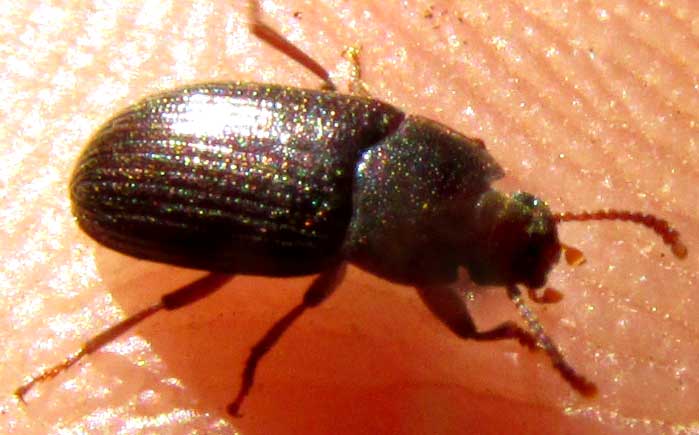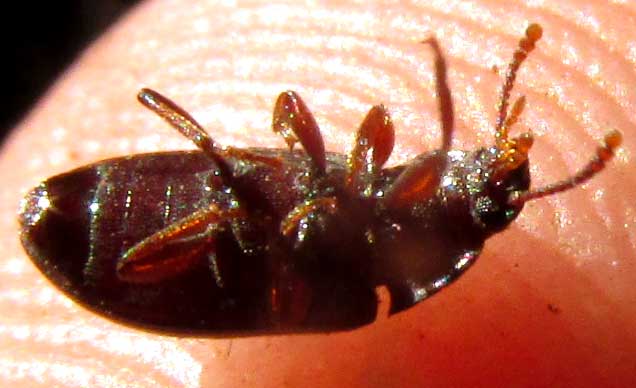Excerpts from Jim Conrad's
Naturalist Newsletter
from the December 10, 2017 Newsletter issued from Rancho Regenesis in the woods ±4kms west of Ek Balam Ruins; elevation ~40m (~130 ft), N20.876°, W88.170°; north-central Yucatán, MÉXICO
"THATCH-ROOF BEETLE"
Last year at the end of the rainy season when I moved from the visitor hut beside the rancho's tool shed to the hut beside the deep pit, in late afternoon of the day when I cleaned the new hut I plopped into my seat to rest. I was pleased with the move, this new lodging seeming to be an improvement over the old one in every way. But then something tiny bounced off my bald head. And then another. And another and another, and before long it was like a shower of tiny somethings falling on and all around me. They were 4mm-long beetles (3/20ths inch), one of which is shown below, on my fingertip:

A flipped-over one is shown below:

At first the rain of beetles didn't concern me, thinking that it must be a one-time occurrence, and remembering that I sleep inside a mosquito net. However, that night many slipped beneath the net and crawled over my body, tickling and keeping me awake. When I picked one off and put him outside the net, I found my fingers stinking mightily, for this beetle protects itself from predators with a stinky exudation. And the next night, the beetle rain was even heavier.
My Maya friends knew all about this beetle, because the insects infest the Guano-Palm thatch roofs of their own homes. However, they'd never experienced a deluge of them like I was seeing. They conjectured that in their own homes the kitchen fire sent smoke filtering through the roof thatch, keeping down beetle populations, so I needed to make a smoky fire in my hut. I did that but it didn't help much. The morning after the worst night of my beetle deluge I swept four liters (quarts) of dead, dying and living beetles from the hut floor. The Maya workers said they could hear the beetles munching the palm thatch above us, but they were too quiet for my ears.
Eventually I learned that the beetles fell from the thatch mainly before afternoon rains. They were the best rain forecasters I'd ever encountered. When the dry season began, their nightly numbers fell to just a few. This year when the rainy season returned, the beetle fall increased, but not much, maybe because by then my own thatch roof had been smoked better.
Of course I wanted to know what kind of beetle I was dealing with. Others in the Yucatan with unsmoked thatch roofs -- such as restaurant owners and hotels catering to foreigners who think that a thatch roof is romantic -- may have the same problem.
But, the Beetle Order is enormous. Unless I'm dealing with a well known garden pest such as the Cucumber Beetle, usually I feel lucky if I can figure out which family the beetle belongs to.
Therefore, when Gilles from Quebec signed in at Genesis in Ek Balam and told me that he managed a large Internet forum for insect enthusiasts, and that professional entomologists sometimes visited it, I jumped at the possibility of having some real beetle experts identify the beetle from my posted photos.
Gilles himself figured out that the beetle belonged to the the Darkling Beetle Family, the Tenebrionidae. When he spoke with some specialists in Neotropical Tenebrionidae, their best guess was that our beetle belongs to the genus BLAPSTINUS. However, without dissecting the beetle and without much work having been done on Blapstinus in our area -- conceivably we have a species not yet known to science -- that's as far as they can go.
So, getting our little beetle to genus level is pretty good. I hope that someday a researcher will be happy to know about my nightly Blapstinus rains, and maybe suggest a species name.